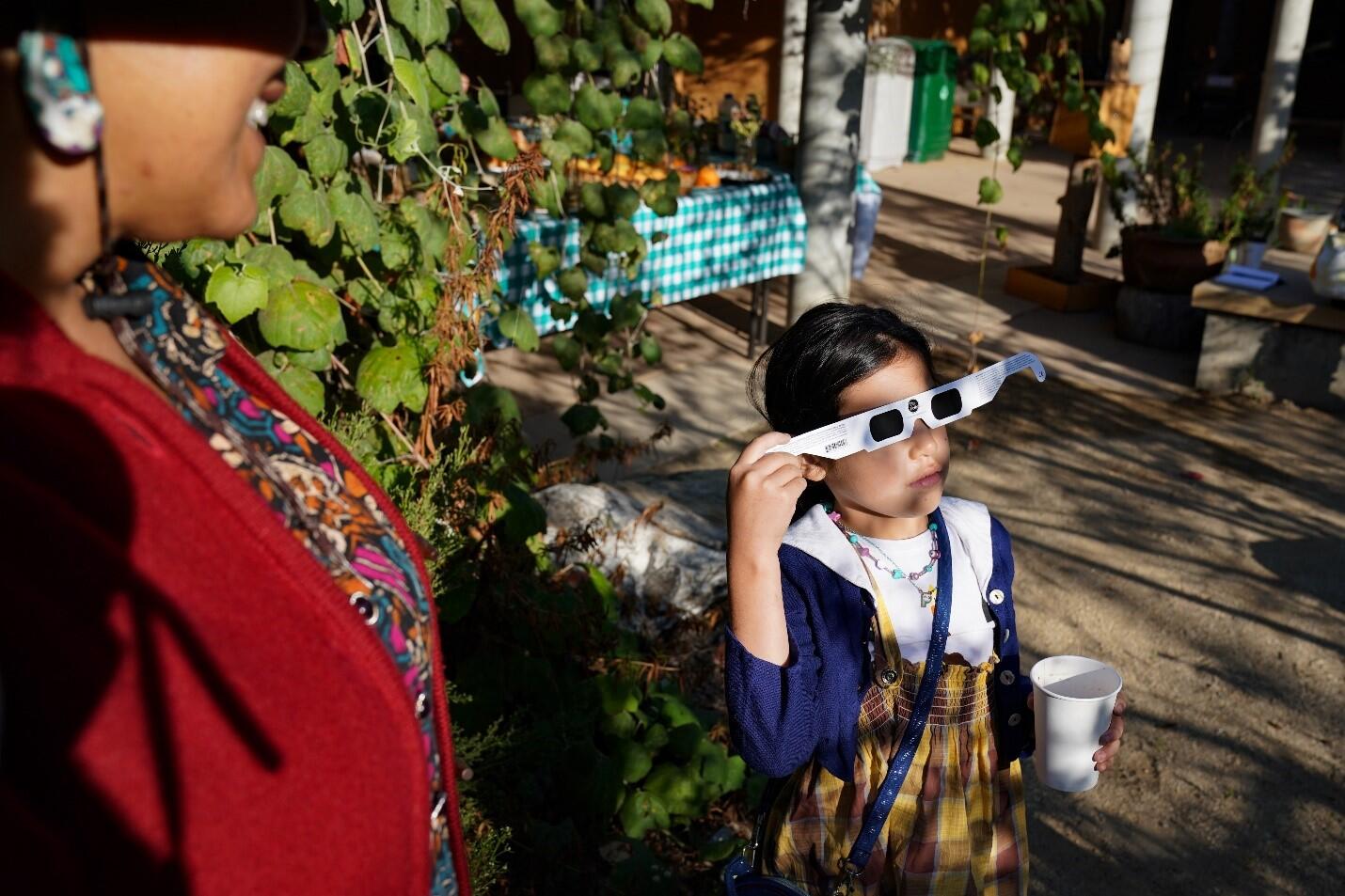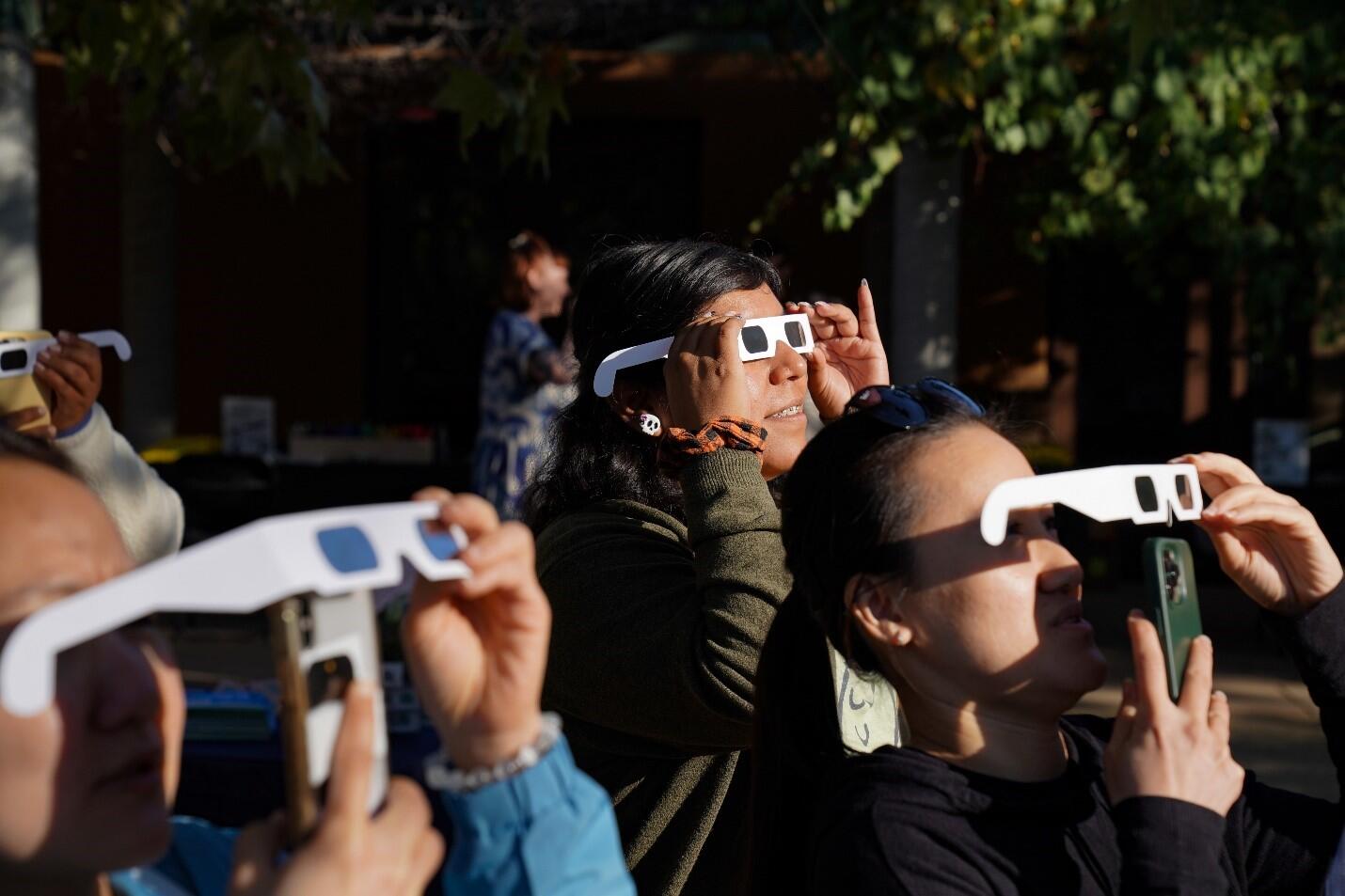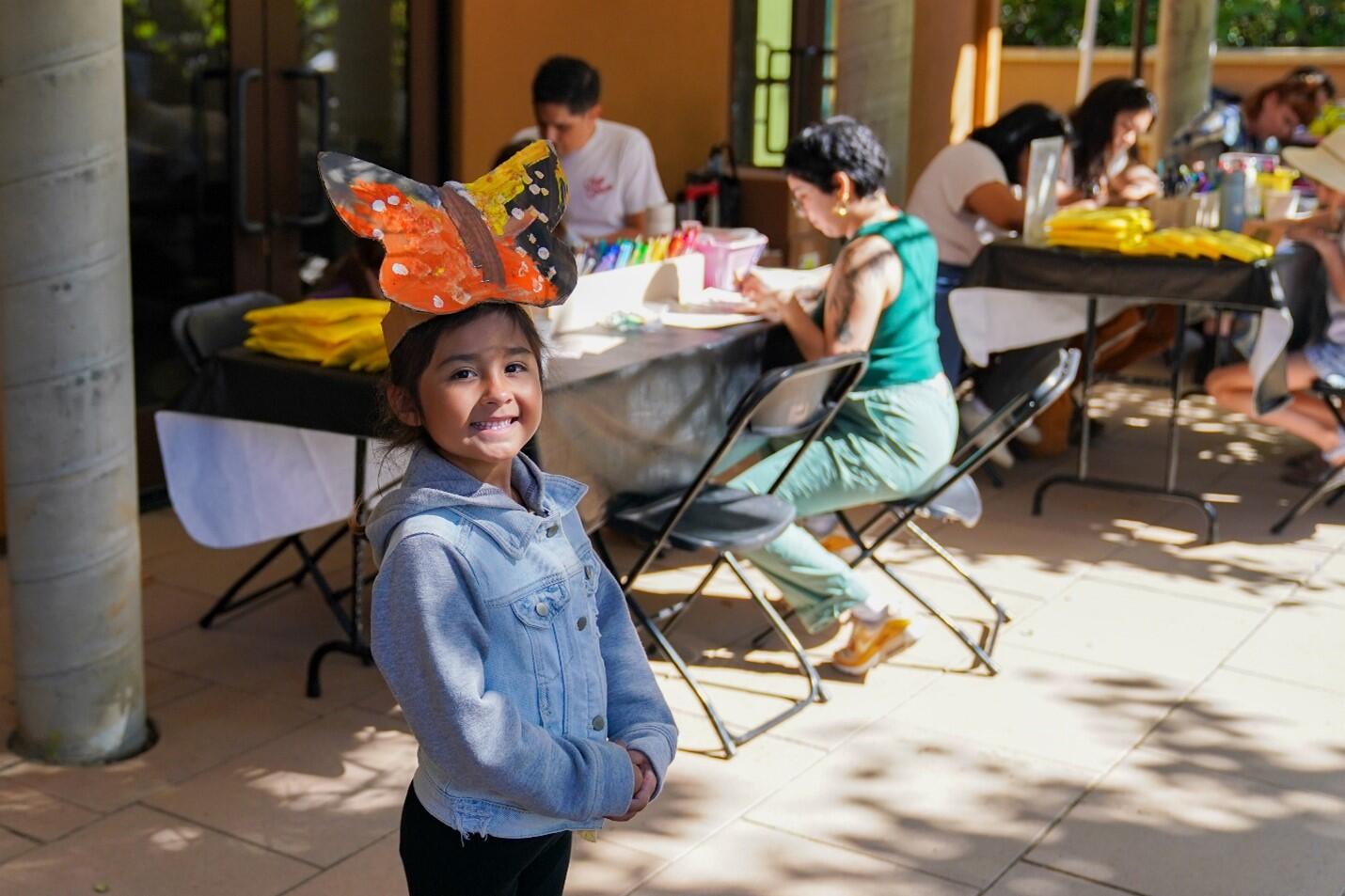The crisp October morning was tinted with a touch of autumn chill as the twittering of pink-green Allen’s Hummingbirds spritzed through the quiet air. Festive papel picado lined the stone-grey pillars and monarch butterfly decorations speckled the Center in their characteristic marigold orange. Beneath the shade of the Center’s emerald green pergolas were wide tables dressed up by community organizations with their own colorful spread of activities.
As the time approached 8:30AM, people of all ages began to walk through our gates, many of whom were visiting the Center for the first time. We welcomed them inside with smiles and handed them solar glasses and a guest pondered them in her small hands, remarking that they looked like 3D glasses.
It was a perfect description for the tool as it was necessary to witness one of the most spectacular and miraculous phenomena of nature in its theater of blue skies: a solar eclipse.
Specifically, on October 14th, 2023, an annular solar eclipse passed through California. Here, at the Audubon Center at Debs Park, we viewed a partial solar eclipse. Nearly 87% of the Sun would be eclipsed by the Moon and while these celestial events happen biannually, it is very rare to view those eclipses in Los Angeles. In fact, the last time we viewed a partial solar eclipse in Los Angeles was in 2017!
Thus, for this year’s Pachanga de las Americas, we wove together the migration of celestial bodies and the migration of birds, butterflies, and people to celebrate the grand tapestry of stories, myths, and shared experiences inspired by the solar eclipse.
In our Welcome Center, guests explored the science behind why solar eclipses happen and why they are considered so special. Guests were tasked with the challenge of finding the perfectly sized Styrofoam ‘Moon’ and the perfect distance to eclipse the Sun – a floor lamp’s lightbulb – in full. As they experimented with different sizes and distances, volunteers discussed with them the sheer artistry of a solar eclipse: our Moon cannot change its size or move its distance from the Sun, it just so happens to be the right size and distance to eclipse the much-larger Sun perfectly.
Opposite to the Welcome Center, the usual Nature Notes board was covered in orange as it promoted the Eclipse SoundScape: a NASA community science “project that was funded by the NASA Science Activation to study how eclipses affect life on Earth.” (Eclipse Soundscapes, https://eclipsesoundscapes.org/”) Guests were encouraged to make observations of how animals and birds to even people and vehicles reacted to the solar eclipse. These observations were then shared with the Eclipse SoundScape project with the message that science is a community effort in which we are all a part of.
We also held WildWords on the Nature Notes board, which was a storytelling space where guests could jot down their memories and stories surrounding the solar eclipse. In this way, our Nature Notes board held both the scientific significance of the solar eclipse and the personal, cultural relation to it. Guests jot down personal stories such as how they were unable to see the last solar eclipse because it occurred during class, to the myths passed down about how solar eclipses were thought to be caused by dogs of fire chasing away the Sun and Moon. It was a nexus for our community to explore how science and stories are linked together.

Pan dulce, muffins, and other breakfast breads were also offered alongside hot cocoa and coffee. Beyond the bridge and into Children’s Woodland were picnic tables with Sharpies precariously hanging off them and rolls of holographic window cling to help guests make their own prismatic sun catchers. These sun catchers not only served to brighten one's windows, but to also keep birds from crashing into them. Guests of all ages from toddlers to elders enjoyed their opportunity to customize a suncatcher of their own; one might even daresay that the adults enjoyed it even more than the children!

Our community organizations also brought this event alive with their own flair and color. Guests had a wide array of artistic activities to choose from: Arroyo Arts Collective’s cardboard monarch butterflies to paint, the mental wellness activities beneath Sunbeams LA’s canopy, and Crush and Touch Art’s tables with numerous coloring pages and even more numerous art supplies and art kits.
National Parks Conservation Association’s information table offered a mountain of goodies to explore their work, Arroyo Seco Regional Branch Library hosted a wonderfully charming StoryWalk event with Señorita Mariposa, and Latino Outdoors held Yo Cuento, recording and sharing stories from the community. Both adults and children took part in embracing a treasured moment of carefree calm as they painted, colored, and formed memories under the Center’s roof. The help of our magnificent community organizations elevated our Pachanga de las Americas to create these opportunities and moments for our guests.
As the peak of the solar eclipse approached, an excited silence blanketed people’s conversations as they began to turn their gaze upward. The dappled sunlight from our Western Sycamore tree had turned into crescent suns on the ground of the sandy courtyard.
Crickets chirped confusingly and the call of birds abated as the blue of the sky seemed to almost deepen. People cracked smiles and whispered ‘wow’.

As the peak of the solar eclipse approached, an excited silence blanketed people’s conversations as they began to turn their gaze upward. The dappled sunlight from our Western Sycamore tree had turned into crescent suns on the ground of the sandy courtyard.
Crickets chirped confusingly and the call of birds abated as the blue of the sky seemed to almost deepen. People cracked smiles and whispered ‘wow’.

When the peak passed, that breath came loose as some people texted their friends, others continued to watch the passage of the Moon in the sky, and the more technically-savvy tried to take a photo of the eclipse with their smartphones. Everyone preserved this moment in their own way, in their own story.
Delightful live music from Susie Hansen Latin Trio flowed through the courtyard as we closed out the event, bidding goodbye to makeshift monarch butterflies bobbing up and down in the crowd of children and parents.

The high noon sun blazed above us, as if the solar eclipse had happened ages ago. The sound of Susie’s electric violin singing through the Center seemed to invite several House Sparrows, which watched from the boughs of trees above the Latin Trio. It was an equally magical moment to the partial solar eclipse and was a perfect example of the way the Audubon Center at Debs Park is a crossroads of nature and community.
All in all, we greeted around 200 guests, volunteers, staff, and community members and are so happy to have been a part of this memory for so many. We hope to continue celebrating the stories of our communities every year at the Audubon Center at Debs Park!


By He Sung Im
Birds in This Story
House Sparrow
Latin: Passer domesticus

Allen's Hummingbird
Latin: Selasphorus sasin




